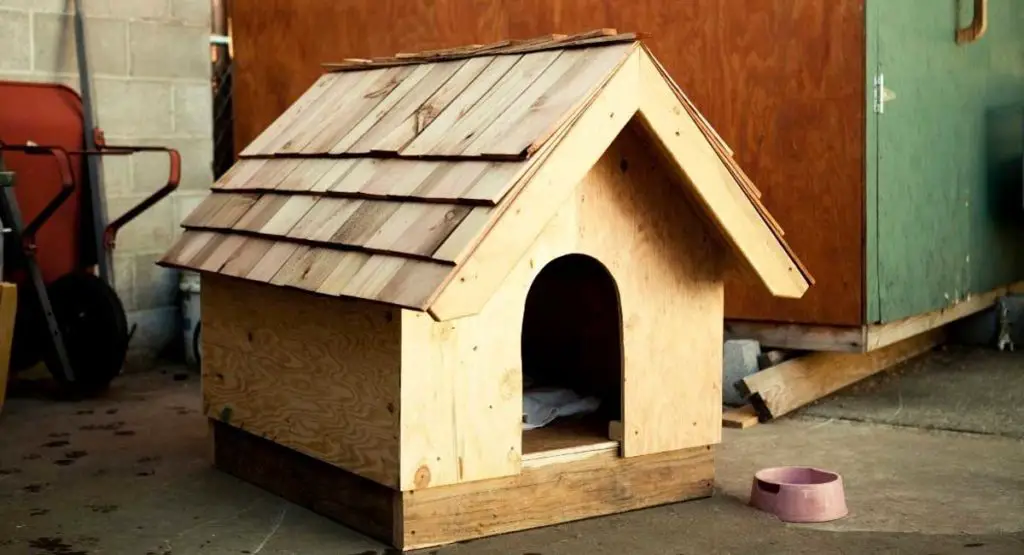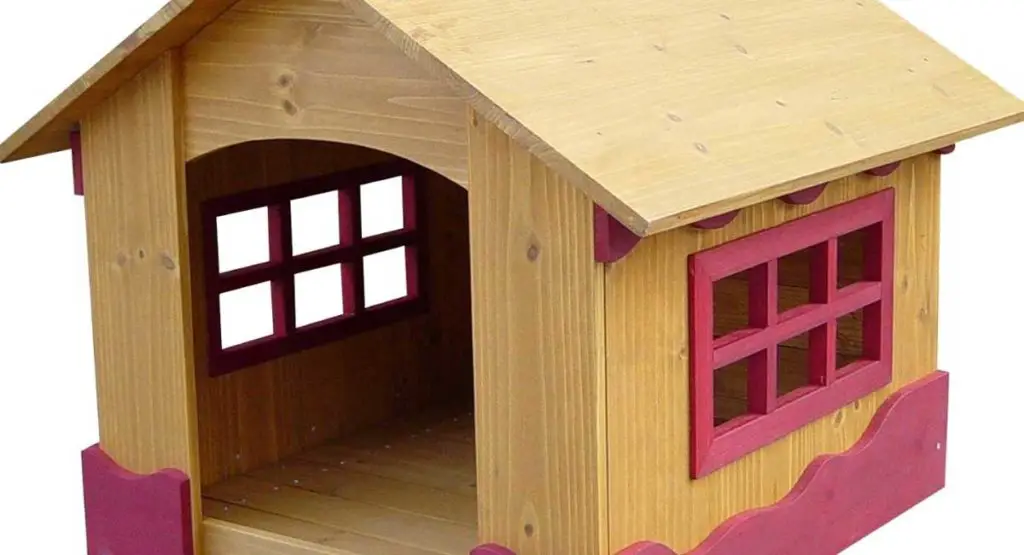If you own a doghouse, then dog house insulation is probably on top of your priority list. If it’s not, it should be! You want to know how much insulation is enough, and how it will affect Fido’s comfort in the summer heat.
The best time to insulate doghouse walls is when you’re building from scratch. That way, you can account for both your dog’s size and warmth requirements.
Already own a dog house? You’re in luck. We have a ton of tips for you.
In this article, you’ll learn about different types of insulation materials and the proper way to insulate every inch of your dog house.

The good news is that these steps are straightforward and simple, and most owners can follow them using tools they can easily find in hardware stores.
We’ll also share other advice, like the best temperatures for your dogs and how to position the outdoor dog house for maximum warmth. Ready? Let’s dive in.
Dog House Insulation Materials and Techniques
Insulating your dog house is a pretty straightforward process. In fact, you may have a few ideas already but just want to follow the best possible advice. On the other hand, you may have no idea where to start. Either way, we have the information you need.
One thing to keep in mind is: it’s crucial to keep your dog’s body from touching any of these items. As you know, dogs love to chew, and some of these materials can be seriously toxic to your pup’s health. A great way around this is to cover the insulation with panels like wood or plastic.
Depending on the structure of your dog house, you may also stuff the insulation material into the walls. This fix is more effective with materials like expanding foam spray.
Let’s jump into the various insulation materials and techniques.
Fiberglass
Fiberglass is a reinforced plastic material made of glass fibers that are arranged in a layered matrix. The matrix is responsible for most of its insulation properties.
Your home probably has some fiberglass installed. It could be in your roofing laminate, door surrounds, or chimneys. Because it’s lightweight and strong, fiberglass also has a ton of versatile applications.
We recommend fiberglass for your dog house insulation for several reasons. First, it is easy to install. Second, it’s more affordable than many items on this list. Finally, it produces a cozy ambience your pooch will love.
Step 1: Lay the Fiberglass
Place the fiberglass on the walls of the doghouse. If the walls are solid, you’ll need to tack or staple the fabric. You’ll also need a layer of covering over the fiberglass to keep your dog away – fiberglass can irritate your pet’s skin and lungs if the airborne fibers are inhaled. Wooden or plastic panels are an easy way to keep your curious dog away from the insulation.
If your dog house is relatively small, consider performing this step outside. That way, you don’t eat into precious indoor space.
Step 2: Use Carpet Insulation
In really cold weather, your dog will benefit from an extra layer of insulation inside. For this, you can hang carpet remnants along the walls. Use a cup hook to hold the remnants in place so you can remove the carpet in the summer to provide extra ventilation.
With this step, just remember to keep a close eye on your pup and make sure she’s not chewing on the carpet remnants.
Step 3: Keep Moisture Out of the House
To keep the moisture out, use synthetic materials like Typar. You can also use traditional house wrap, but Typar will shed more water more quickly.
The only downside is that once moisture gets into the doghouse, it stays trapped inside, and can cause wood to rot. This means you’ll need to stay vigilant in the rainy season.
Bubble Wrap
Bubble wrap is a pretty ingenious insulation material. It’s nothing but plastic film, aluminum, and air pockets. Surprisingly, these form a pretty strong insulation material. Bubble wrap is also very easy to install because of how malleable it is.
You may be thinking, hey, bubble wrap doesn’t have any aluminum! Well, the regular bubble wrap doesn’t, but some types are designed specifically for insulation.
Insulation bubble wrap uses the trapped air bubbles to keep the dog house warm. Genius, right? When shopping, remember to ask specifically for the kind used for insulation.
Step 1: Lay Down the Wrap and Cover it Up
This step is very simple, and you can use staples, tacks, or glue. Be sure to get as much of the surface area as possible.
You’ll also need to cover up the wrap using wood or plastic panels to keep your dog from chewing. We all know how enjoyable popping bubble wrap can be!
Reflective Foil
Reflective foil is another great option for insulating your dog house. We love it because it uses your dog’s body heat to keep the house warm by bouncing all the heat back.
Reflective foil is affordable and very easy to install. You simply glue it over the desired area.
One more perk of this material is that you can combine it with other insulation materials for even more warmth. For example, you could first lay the reflective foil, then fiberglass or bubble wrap, and then add the wood panels.
Step 1: Glue the Reflective Foil
You want to use glue because the foil could rip through the staples and curl up, exposing parts of your dog house.
Step 2: Add on Another Layer of Insulation (optional)
You can choose to lay a bonus second round of insulation using glue or staples, and it will hold. And since the second insulation is directly over the foil, you don’t have to worry about it curling up.
Last, add the carpet remnants or panels to keep your dog away.
Foam Spray
Expanding foam spray is perfect for small spaces like holes and gaps in your dog house. It provides top-notch insulation with relatively easy installation – you simply spray it. Since it expands, you don’t have to worry about plugging the hole with some clever technique.
Expanding foam spray works well in both warm and cold weather, doesn’t absorb any water, and keeps mold at bay. Basically, it has all the benefits that materials like fiberglass lack.
However, you should be warned that foam spray has some drawbacks. For example, it can be costly, especially compared with other insulation materials on this list. Also, if you’re planning to use it in a larger space you’ll need more than just the can. You’d also have to get proper safety and spray equipment.
Step 1: Identify and Spray Holes and Gaps
Find, point, and spray. It’s that simple.
Step 2: Cover the Spray Foam
Earlier we mentioned how you’d need safety equipment to use expanding spray foam on a large scale because of how hazardous it can be. That’s why it’s important to cover it to keep your pup from direct exposure. You can use wood panels for this.
Step 3: Use Foam During Construction (Conditional)
Spray foam is most effective when it’s between the inner and outer walls of your dog house. This way, your dog is protected from it, and it offers a greater area of insulation.
Lightweight polystyrene foam
If the name sounds familiar, that’s because another popular material, styrofoam, is made from polystyrene foam. However, styrofoam is a trademarked term for a special kind of polystyrene.
It’s so popular that you can find it in everything from insulated coffee cups to coolers.
Polystyrene foam is one of the best insulation options for your dog house. It’s cheap, easy to install, and very popular. One thing we love about polystyrene is that it’s available in varying thicknesses. This allows you to choose insulation levels without having to double up on material.
The problem with polystyrene is that it isn’t as durable as other insulation methods.
Step 1: Lay the Panels
If you’re installing the panel in a tight space, be sure it’s 1 cm wider than the desired area. If the panel isn’t wide enough and it falls out, you can use plastic reinforcing clips to hold it in place.
Step 2: Cover the Insulated Area
By now, you know the drill. Keep your dog away from the insulation using by wood or plastic panels.
Less Effective Insulation Materials
Two materials in this category are wood and carpet. They work, but they’re not great.
Wood
Wood is not an insulator in itself; instead, you use it to reinforce other insulation. However, in a pinch, wood is better than zero insulation. Because it’s a poor conductor of heat, it can form a barrier between your dog and the cold weather outside.
To install, ensure that the wood panels cover the exact dimensions of the wall. It also helps to apply water sealant to the wood before installation. This will not only provide an extra insulation layer but will also extend the wood’s lifespan.
Softwood is better for insulation than hardwood because it contains more air pockets.
Carpet
Carpet is not an ideal insulation material – it costs more than many other options, but without providing the same insulation. If you look around, you may get carpet for cheap from a supplier in your area. That is, if you’re willing to work with whatever colors and patterns they have.
However, it’s quite effective, especially on the floor and ceiling of your dog house. Outdoor carpets are better than indoor ones because of the increased durability.
If you’re installing the carpet on the roof, or walls, be sure to use a strong glue product.
Insulating the floor and ceiling
You can use any of the materials we just discussed to insulate your doghouse floor. In addition, you can also use the following tricks for even more warmth.

Floor
Because your dog is always in contact with the floor, it helps to take extra precautions. For example, installing a vapor barrier between the house floor and the actual ground can help trap warm air. You can make a vapor barrier by laying a tarp or heavy plastic sheet.
To insulate the ground further, create a platform under the doghouse. By separating the house from the ground, you eliminate extra cold from wet conditions. You can use a wooden pallet and insulate it with bubble wrap or foam sheets.
Ceiling
Your pooch will thank you for an insulated ceiling, especially in cold winter temperatures. You can insulate the ceiling using everything from foil-faced paper to bubble wraps.
Foil-faced paper is an excellent choice for creating a warm dog house when space is an issue. It’s flat, easy to install, and can cover every inch of the ceiling. Be sure to cover the paper with plywood so your dog doesn’t rip it up.
In a larger dog house, use rigid foam insulation to keep out the winter cold and create some thermal resistance. You should also cover it with some plywood.
Install a tarp on the outdoor dog house to improve heat retention and reduce the loss of heat. A tarp is also quite easy to remove in the summer to improve natural ventilation, so, bonus!
Positioning the Outdoor Dog House for Extra Warmth
Normal storms move from west to east in the US. Because of this, it’s a good idea to position your dog house facing east. If you can position it so that your home is between the storm and the outdoor doghouse, even better. Work with nature, not against her.
Additionally, it’s important to get a house that’s the right size for your dog. That way, Fido’s body warmth can circulate as it bounces between the layers of insulation.
Recommended dimensions state that your doghouse should be 12″ plus the width of your dog, 18″ plus the length of your dog, and 9″ plus your dog’s height. This way, your pet is comfortable enough to actually live in the house, and there’s enough room for the warm air to circulate.
Finally, you may want to consider getting a heating device. This is a good idea if your dog house is still colder than the recommended temperatures.
A heating device also makes it easier to control the warmth in the doghouse. You can simply turn it off in the summer, unlike insulation techniques that require you to uninstall certain modifications.
Great heating devices for dogs range from heating pads to kennel heaters and even indoor panel heaters.
Should You Invest in a Plastic or Wooden Dog House?
Sometimes, the best thing you can do for your dog’s warmth is choosing the right house. Both plastic and wooden houses are great, but when it comes to warmth, wooden houses definitely have the edge.
Plastic has a low insulation factor, and your dog will only depend on its body heat for warmth. They are colder in the winter and can heat up pretty quickly in warm weather.
Heavy-duty plastic dog houses may fare better in cold weather, according tofindanyanswer. They are naturally insulated because of the extra plastic layers, which is a good thing
Wood, on the other hand, is a pretty good insulator, as we’ve already seen. It can even be used to insulate plastic houses in some instances.
What’s the Right Temperature for a Dog House?
According tofamilyhandyman, most dogs are comfortable between 68 and 78 degrees Fahrenheit. Lower temperatures can trigger all kinds of reactions in your dogs, from flaring arthritis to downright hypothermia.
Dogs with small bodies and short hair are even more susceptible to cold, so you should pay extra attention to their warmth needs.
It’s a good idea to install a thermometer in your pup’s house. That way, you can monitor the temperatures. If you’re planning to get a heating device, look out for one with an in-built thermometer, because hey, two birds with one stone!
The Bottom Line
Insulated dog houses help keep your beloved canine cozy, warm, and comfortable in the winter months. It helps to take a systematic approach to insulation, starting from finding the right materials, to picking the right spot for the dog house.
There are several dog house insulation materials out there, and they all have their merits, from the easy-to-install fiberglass to the oddly familiar insulation bubble wrap.
In a pinch, you can also use materials like wood and carpet to provide a much-needed layer of insulation.
Insulation is great, but what’s even better is picking the right doghouse from the start. Wooden dog houses tend to retain more heat and are thus better insulated. Also, be sure to position the house away from storms and cold winds.
If you live in really cold regions, realize that all these steps may not be sufficient. Sometimes, you’ll have to bring your pup indoors to keep it warm – that may not be such a bad thing after all.






